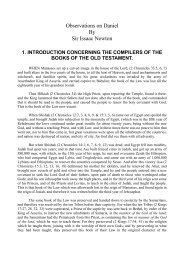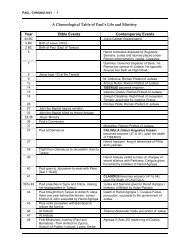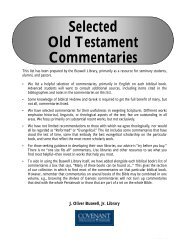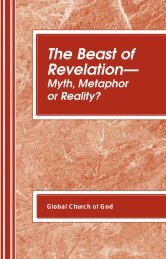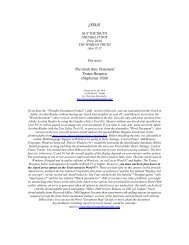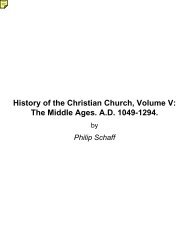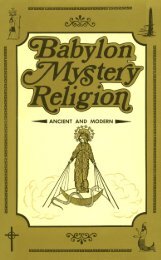Nazarenes_and Ebionites_Rogers.pdf - Friends of the Sabbath ...
Nazarenes_and Ebionites_Rogers.pdf - Friends of the Sabbath ...
Nazarenes_and Ebionites_Rogers.pdf - Friends of the Sabbath ...
Create successful ePaper yourself
Turn your PDF publications into a flip-book with our unique Google optimized e-Paper software.
mental <strong>and</strong> emotional reaction to such a tremendous experience, <strong>and</strong> what<br />
was <strong>the</strong> reason which led <strong>the</strong> Gentile Christians apparently to allow so epochmaking<br />
an event as <strong>the</strong> destruction <strong>of</strong> <strong>the</strong> citadel <strong>of</strong> Judaism <strong>and</strong> <strong>the</strong><br />
disappearance <strong>of</strong> <strong>the</strong> Mo<strong>the</strong>r Church to pass uncommemorated. Of this<br />
incredible period church historian, Hurlbut, writes:<br />
“For fifty years after Paul’s life, a curtain hangs over <strong>the</strong> church,<br />
through which we vainly strive to look; <strong>and</strong> when at last it rises,<br />
about 129 A.D. with <strong>the</strong> writings <strong>of</strong> <strong>the</strong> earliest Church Fa<strong>the</strong>rs,<br />
we find a church in many ways very different from that in <strong>the</strong><br />
days <strong>of</strong> Peter <strong>and</strong> Paul.” [9]<br />
Edward Gibbon states:<br />
“The scanty <strong>and</strong> suspicious materials <strong>of</strong> ecclesiastical history<br />
seldom enable us to dispel <strong>the</strong> dark cloud that hangs over <strong>the</strong><br />
first age <strong>of</strong> <strong>the</strong> church.” [10]<br />
What happened during this time? Obviously, it was a time <strong>of</strong> many heresies.<br />
The Church Fa<strong>the</strong>rs come on <strong>the</strong> scene in <strong>the</strong> second century to tell us<br />
vociferously who <strong>the</strong> heretics were <strong>and</strong> where <strong>the</strong> “orthodox church” was.<br />
These men claimed to be <strong>the</strong> followers <strong>of</strong> <strong>the</strong> apostles but <strong>the</strong>ir <strong>the</strong>ology was<br />
different <strong>and</strong> seemed to blend Hellenistic philosophy <strong>and</strong> Babylonian religious<br />
custom with Christianity.<br />
It was certainly a far different <strong>the</strong>ology from that <strong>of</strong> <strong>the</strong> Jerusalem Church<br />
which Paul said he had taught <strong>the</strong> Gentiles to follow (Acts 15:2, 22-28; I<br />
Thes. 2:14). It is interesting that <strong>the</strong> descendants <strong>of</strong> <strong>the</strong> Jerusalem Church, <strong>the</strong><br />
<strong>Nazarenes</strong>, were labeled as heretics <strong>and</strong> persecuted for <strong>the</strong>ir regard <strong>of</strong> <strong>the</strong><br />
Mosaic law when <strong>the</strong>y were merely carrying on <strong>the</strong> tradition <strong>of</strong> <strong>the</strong> church <strong>of</strong><br />
Peter <strong>and</strong> James.<br />
Flight to Pella<br />
In <strong>the</strong> absence <strong>of</strong> any explicit statement in <strong>the</strong> NT or subapostolic documents,<br />
we are left to find our earliest, most complete, <strong>and</strong> almost only information<br />
about <strong>the</strong> fate <strong>of</strong> <strong>the</strong> Jerusalem Church in <strong>the</strong> fourth century Ecclesiastical<br />
History <strong>of</strong> Eusebius, which is substantially reproduced in <strong>the</strong> next century by<br />
Epiphanius.



